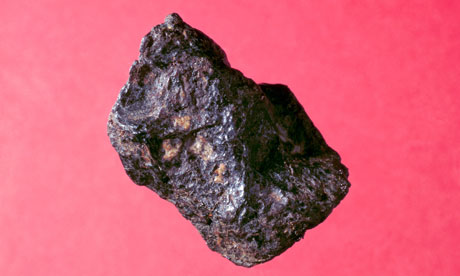
A nickel iron meteorite found in Arizona, US. Photograph: Leslie Garland Picture Library/Alamy
In 1998 Hollywood offered us two meteorite-heavy films (Armageddon and Deep Impact) and, along with them, two potential solutions to stave off an impending meteorite-based disaster: either enlist Bruce Willis and Aerosmith to travel into space and blow up the offending rocks, or install Morgan Freeman as president and hope the whole thing blows over. The apparently planet-threatening rocks were back in the headlines this week with the sensationalist news that a 4.5bn-year-old meteorite had hurtled into the roof of a Parisian home – housing a family called the Comettes, no less. Despite their builder claiming that only Superman himself had the strength to break the tiles, the 3.5oz meteorite in question became lodged in the house's glass wool insulation and was said to be the size of an egg. Madame Comette proudly chirped: "A meteorite landing in your garden is magical and more unlikely than winning the lottery."
The prosaic reality of these occurrences are trumped only by their rarity, with the odds of being hit usually estimated to be several hundred thousand to one. In 2009, a 14-year-old German boy, Gerrit Blank, came into contact with a 30,000mph meteorite, escaping with minor scars. Alabama resident Ann Hodges had a similar encounter in 1954 when a meteorite blasted through her roof while she was sleeping and pinged off her radio before grazing her on the hip. One apocryphal story among astronomers involves the so-called "Nakhla meteorite" which was said to have struck a dog in 1911, though the canine's remains have never been found.
As for wayward space systems re-entering Earth's orbit, the mass speculation about where these satellites will land upon returning to their planet of origin is often more interesting than the event itself. Momentary hysteria broke out earlier in the year when the six-tonne Upper Atmo sphere Research Satellite, launched in 1991 from the space shuttle Discovery, threatened to fall to Earth at an unknown location. Despite anxiety that this bus-sized block of detritus would somehow engulf us all, it crashed to little fanfare, mostly breaking up over the ocean. A similar fate befell the Soviet Union space system Salyut 7 in the early 1990s when it crumbled over the Argentinian town of Capitán Bermúdez, scattering metal as it went, but leaving its residents unharmed. The best known of these incidents remains the premature return of Nasa's Skylab system in 1979. Its remains were spread over the Australian coastline and the town of Esperance to little incident, though the San Francisco Examiner offered $10,000 to the first person to who could provide the paper with a hunk of the space junk.
The only recorded person found to have been actually hit by falling space garbage was Oklahoma resident Lottie Williams, who received a knock to the shoulder by debris from a Delta 2 rocket booster when walking through a park in 1997, resurfacing to tell her tale only this year. "I just want people to know this actually happened," said Lottie, going on to mention that the whole banal affair was roughly about the same as being hit by an "empty soda can". Bruce Willis et al, take note.
http://www.guardian.co.uk/science/2011/oct/16/meteorite-strike-madame-comette
No comments:
Post a Comment